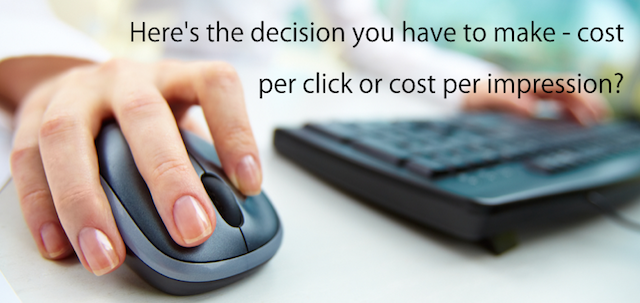 Eliza Gniadek
created
Eliza Gniadek
created
Cost per click vs. cost per impression
Back to list of articlesAre you getting the most out of your online advertising initiative? If you are focused too heavily on cost per click (called also pay per click), chances are you are missing out on at least part – and possibly a significant part – of the revenue your content could be generating. The same holds true for relying too heavily on cost per impression (CPI). There are clearly instances when one method or the other will work more to your advantage.

CPC and CPI explained
Cost per click is an online advertising model wherein someone places an ad on a website and is paid by the advertiser whenever a site visitor clicks on the ad. It doesn't matter if the visitor buys anything; if the advertiser gets the click, it pays the site owner an agreed-upon fee for hosting the ad.
Cost per impression is a bit different. An impression is any instance wherein an ad appears on a Web page. Advertisers routinely pay for the number of times their ad appears on a specific page or site. The advertisers pay a fee whether the ad is clicked or not.
Let's have a look now at the advantages and disadvantages of each.
CPC pros and cons
One of the attractive attributes of CPC is that you have the freedom to set your own advertising budget. You decide exactly how much you want to spend to get clicks for your ad. Once you have exhausted your daily budget, your ads will not appear again until the next day. You also have the option of setting your ads to target specific keywords so they only appear on sites with content that at least loosely matches the subject of the ad. This increases the probability of capturing a click.
CPC also offers much faster results than relying solely on your SEO efforts to generate organic search engine traffic. It can literally take years to build up the traffic you can generate using CPC when you rely on SEO to get the job done.
In the minus column, bidding wars over ad position are common with CPC, and it can get expensive with a less-than-attractive ROI, especially if you get too aggressive in your bidding. In addition, charges for each click vary drastically. The higher the keyword position, the more you're going to pay. CPC costs can range from a few cents to $50 or more.
CPI pros and cons
CPI works best in advertising campaigns where a high click-through rate is likely. An accurate projection of clicks could save you considerably over CPC. It is also a great avenue for raising awareness of your product, service, or brand. It actually creates a way of building brand recognition at a relatively low cost.
Conversely, on sites where traffic is low, the investment in CPI will probably not have a very good ROI, and on websites with high traffic, your ad could easily get lost in the shuffle, making it difficult to capture clicks. It is also more difficult to gauge the effectiveness of branding campaigns, since it is difficult to track click-throughs.

So which is the better option? Clearly, there are a number of variables, but here is a simple checklist for each:
Use CPC if:
- You want to accurately track the number of clicks your ad is getting.
- You want to control how much money you spend on ad traffic.
- You are a disciplined advertiser who sticks to your budget and doesn't get into bidding wars.
- You want to advertise on high-traffic sites and get the benefit of both clicks and exposure.
Use CPI if:
- You can realistically expect a high click-through rate on your ad.
- You are executing a launch for a new product or service.
- You are trying to build recognition for your brand without spending your entire budget on that one area of your marketing strategy.

